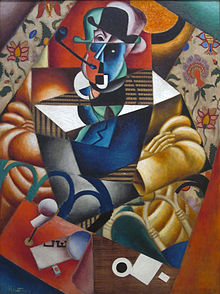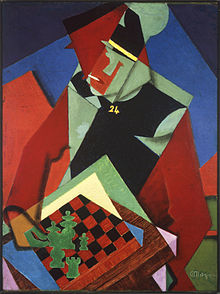Jean Metzinger
Metzinger was at the center of Cubism both because of his participation and identification of the movement when it first emerged, because of his role as intermediary among the Bateau-Lavoir group and the Section d'Or Cubists, and above all because of his artistic personality.
The establishing of the basis of this new perspective, and the principles upon which an essentially non-representational art could be built, led to La Peinture et ses lois (Painting and its Laws), written by Albert Gleizes in 1922–23.
For inspiration, Niels Bohr, the Danish physicist and one of the founders of quantum mechanics, hung in his office a large painting by Metzinger, La Femme au Cheval,[8] a conspicuous early example of "mobile perspective" implementation (also called simultaneity).
[22] In this exhibition Metzinger is directly associated with the artists soon to be known as Fauves: Camoin, Delaunay, Derain, van Dongen, Dufy, Friesz, Manguin, Marquet, Matisse, Valtat, Vlaminck and others.
[26] From 21 December 1908 to 15 January 1909, Metzinger exhibited at the gallery of Wilhelm Uhde, rue Notre-Dame-des-Champs (Paris) with Georges Braque, Sonia Delaunay, André Derain, Raoul Dufy, Auguste Herbin, Jules Pascin and Pablo Picasso.
)"[30][31] The vibrating image of the sun in Metzinger's painting, and so too of Delaunay's Paysage au disque (1906–1907), "is an homage to the decomposition of spectral light that lay at the heart of Neo-Impressionist color theory...".
[30][33][34] Jean Metzinger's mosaic-like Divisionist technique had its parallel in literature; a characteristic of the alliance between Symbolist writers and Neo-Impressionist artists: I ask of divided brushwork not the objective rendering of light, but iridescences and certain aspects of color still foreign to painting.
I make a kind of chromatic versification and for syllables I use strokes which, variable in quantity, cannot differ in dimension without modifying the rhythm of a pictorial phraseology destined to translate the diverse emotions aroused by nature.
The interesting history of the word "cube" goes back at least to May 1901 when Jean Béral, reviewing Cross's work at the Indépendants in Art et Littérature, commented that he "uses a large and square pointillism, giving the impression of mosaic.
[30] In 1910 Gelett Burgess writes in The Wild Men of Paris: "Metzinger once did gorgeous mosaics of pure pigment, each little square of color not quite touching the next, so that an effect of vibrant light should result.
[19][38] Louis Vauxcelles, in his review of the 26th Salon des Indépendants (1910), made a passing and imprecise reference to Metzinger, Gleizes, Delaunay, Léger and Le Fauconnier, as "ignorant geometers, reducing the human body, the site, to pallid cubes.
Metzinger, Gleizes, Le Fauconnier, Delaunay, Léger and Marie Laurencin were shown together in Room 41 of the 1911 Salon des Indépendants, which provoked the 'involuntary scandal' out of which Cubism emerged and spread in Paris, in France and throughout the world.
In 1912 Metzinger was the leading figure in the first exhibition of Cubism in Spain[47] at Galeries Dalmau, Barcelona, with Albert Gleizes, Marcel Duchamp, Henri Le Fauconnier, Juan Gris, Marie Laurencin, and August Agero.
In his Anecdotiques of 16 October 1911, the poet proudly states: "I am honored to be the first model of a Cubist painter, Jean Metzinger, for a portrait exhibited in 1910 at the Salon des Indépendants."
Vacating these non-essential features would lead Metzinger on a path towards Soldier at a Game of Chess (1914–15), and a host of works created after the artist's demobilization as a medical orderly during the war, such as L'infirmière (The Nurse) location unknown, and Femme au miroir, private collection.
[19] Before Maurice Raynal coined the term Crystal Cubism, one critic by the name of Aloës Duarvel, writing in L'Élan, referred to Metzinger's entry exhibited at Galerie Bernheim-Jeune (28 December 1915 – 15 January 1916) as 'jewellery' ("joaillerie").
This can be seen in many figures: From the division (in two) of the model's features emerges a subtle profile view—resulting from a free and mobile perspective used by Metzinger to some extent as early as 1908 to constitute the image of a whole—one that includes the fourth dimension.
It was too Metzinger's role as a mediator between the general public, Picasso, Braque and other aspiring artists (such as Gleizes, Delaunay, Le Fauconnier and Léger) that places him directly at the center of Cubism.
Daniel Robbins writes: Jean Metzinger was at the center of Cubism, not only because of his role as intermediary among the orthodox Montmartre group and right bank or Passy Cubists, not only because of his great identification with the movement when it was recognized, but above all because of his artistic personality.
Metzinger, for example, writes in a Pan article, two years before the publication of Du "Cubisme", that the greatest challenge to the modern artist is not to 'cancel' tradition, but to accept "it is in us," acquired by living.
[19] Whereas Cézanne had been influential to the development of Metzinger's Cubism between 1908 and 1911, during its most expressionistic phase, the work of Seurat would once again attract attention from the Cubists and Futurists between 1911 and 1914, when flatter geometric structures were being produced.
The reason classical painting fell short of its goal, according to Metzinger and Gleizes, is that it attempted to represent the real world as a moment in time, in the belief that it was 3-dimensional and geometrically Euclidean.
[64] The question of whether the theoretical aspects of Cubism enunciated by Metzinger and Gleizes bore any relation to the development in science at the beginning of the twentieth century has been vigorously disputed by art critics, historians and scientists alike.
Yet in Du "Cubisme" Jean Metzinger and Albert Gleizes articulate: "If we wished to relate the space of the [Cubist] painters to geometry, we should have to refer it to the non-Euclidean mathematicians; we should have to study, at some length, certain of Riemann's theorems."
[...] he wishes to develop the visual field by multiplying it, to inscribe them all in the space of the same canvas: it is then that the cube will play a role, for Metzinger will utilize this means to reestablish the equilibrium that these audacious inscriptions will have momentarily broken.
Princet brought to attention of these artists a book entitled Traité élémentaire de géométrie à quatre dimensions by Esprit Jouffret (1903) a popularization of Poincaré's Science and Hypothesis.
"[68] Niels Bohr (1885–1962), the Danish physicist and one of the principle founders of quantum mechanics, had hung in his office a large painting by Jean Metzinger, La Femme au Cheval (Woman with a horse) 1911–12 (now in the Statens Museum for Kunst, National Gallery of Denmark).
After 1930, until his death in 1956, Metzinger turned towards a more classical or decorative approach to painting with elements of Surrealism, still concerned with questions of form, volume, dimension, relative position and relationship of figures, along with visible geometric properties of space.
Metzinger was commissioned to paint a large mural, Mystique of Travel, which he executed for the Salle de Cinema in the railway pavilion of the Exposition Internationale des Arts et Techniques dans la Vie Moderne, Paris 1937.
Over 80 paintings and drawings, along with documents, films and 15 works by other members of the Section d'Or group (Villon, Duchamp-Villon, Kupka, Le Fauconnier, Lhote, La Fresnaye, Survage, Herbin, Marcoussis, Archipenko...) are included in the show.



















